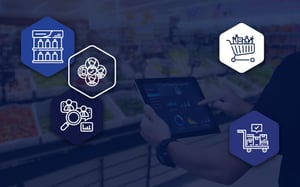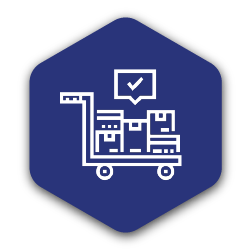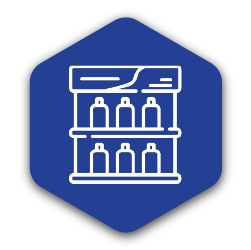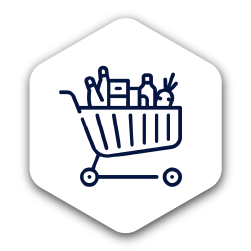It’s well-known that data is part of everyday life and business. We’ve written about that from a retail perspective extensively on this blog. Of course, those pieces focus primarily on the data you can collect about your retail business. There is also a gap. That gap is customer data and how you can use such information to your benefit.
Why is it worth emphasizing this data type? Besides the point that it’s the type of information that helps you better understand your customers - there are plenty of interesting statistics to consider.
Here’s one:
Customers spend 69% of their discretionary income each month in-store
With that high percentage, why wouldn’t you want to understand what your customers are buying? This article explores five steps you can take to put any collected customer data to work in your business. More importantly, by providing a clear, insightful understanding of this data type, you’d be positioned better to take full advantage of it.

Step 1: Analyse any customer data you collect
To understand your customers, you first need to know what they are buying, how much of an item they are buying, and when they buy it. That's the gist of customer data:
Customer data exist as specific information about a customer, that is generated when they interact with or use a product you have on offer. As a retailer, you must understand their needs and wants to provide them with the products they want, when they want them at the price they can afford.
You can usually break this data down into three specific types:
- Personal data: This considers a customer’s demographics (age, ethnicity, income, education, marital status)
- Preferential data: This focuses on what a customer likes or dislike, their loyalty levels, how they shop, and whether they are price-sensitive or not.
- Behavioral data: This looks at how your customers interact with your store.
So how can you collect this information? Shopify’s Ana Cvetkovic lists a few options: it includes, amongst others, your Point of Sales system, surveys, in-store events, social media, and market research.
Of course, collecting this information is only half the battle. It’s what you can do with the collected data that can make all the difference to your business.
For example, once you have the data in hand, you can analyze your fast-moving lines. That allows you to understand what your customers are buying and what’s sitting on your shelf with low sales. That’s not the only benefit of analyzing your customer data.
You can also expect to achieve the following:
- Identify characteristics of these fast-moving lines: This allows you to set them apart from the rest based on customer preferences so that you can bring more of these products in;
- Identify seasonal trends by looking at your sales for specific periods. Again, this allows you to identify which products to bring in at which time of the year.
- Establish whether certain products increase or decrease at predictable times. This ensures you can provide a consistent product assortment that generates customer demand.
Step 2: Optimise your assortment offering
Having analyzed your data, you can now understand which products work well in your business and which don't, based on customer behavior. This behavior also includes customer buying habits.
Customer data gives you a bird’s eye view of which products perform and which of those are slow movers so you can make smarter business decisions.
What type of decisions?
For one, you can use customer trends to adjust your product offering. Are they buying more of a particular brand over another one? Now is the time to focus on stocking more of that brand. Have you noticed customers buying less and less of a once-popular item? It's time to consider removing it from your shelves and replacing it with something else.
There is no shame in admitting that a product isn’t performing as it should be, so long as you're prepared to replace it.
You can also use geographical data to adjust your offerings in each region according to what the data tells you. It’s fundamentally the same principle as what we wrote about above - an item might sell well inland but struggle on the coast, for example. With the customer data to back you up, you can decide to delist the product or brand in specific stores. Meanwhile, you can increase the quantity in other stores to meet demand.
Optimising your product assortment will only be of real value when using the right data. When you fail to analyse and adjust your offering, a category can confuse customers, which results in limited sales growth and wasted shelf space.
The key to optimizing your assortment is to sell the right products in the right stores while making the best use of the space within these stores.
This leads us to step three - allocating the correct shelf space for your products. After all, what good is an optimized assortment that does not fit onto the shelf?
Step 3: Allocate shelf space for products
With your product assortment optimized, the next step is to allocate your shelf space accordingly. It’s at this point that it becomes that much more critical to use the data you have.
Why?
Consider this question: would you give shelf space to a product with little to no monthly sales? Of course not. Your shelf space is one of your prized assets, and you want to maximize it.
It thus makes sense to focus on giving more space instead to those products with the biggest margins.
Download our free retail analytics ebook and learn how to use data to your advantage
If Product A sells more than Product B, you'd want to give it more shelf space to maximize your sales and profits. You'd also like to have a range of products that meet customer demand. If customers buy more of Product A than Product B, but you give less shelf to the top-selling product, that'll frustrate and anger them.
Here it is in a nutshell. Analyzing your customer data correctly allows you to:
- Allocate more space to fast-movers so that you can increase sales;
- Allocate less space to slow-movers, bearing sizing constraints, so that there is adequate space for fast-movers; and
- Allocate more or less space to seasonal items, in line with the specific time of year.
Imagine, for example, your shoppers enjoy a new variety of canned sweetcorn that you recently introduced to your store. The demand for this canned sweetcorn increases exponentially. However, with no analysis done, the sweetcorn stays on the bottom of the shelf with only a few facings for the customers to find.
While you might order more sweetcorn, you have not considered the full potential of this product in terms of sales and thus have not adjusted the space allocation and placement of the product to meet this increase in demand.
Your customers can’t find the item because you have misplaced it on the shelf, which leads to a loss in sales.
Step 4: Personalise the shopping experience
Your customers expect to have a pleasant shopping experience whenever they visit your store. That’s especially true if you consider the shift in how customers shop post-COVID and beyond.
EY Global Delivery Services SAP, Microsoft, and Supply Chain Leader, Sukesh Choubey write that CPG companies need to “reinvent the in-store experience to reduce friction and ensure customers see value in coming back to stores”.
Using the customer data you collect, you can ensure that happens.
Have you ever wondered why you’d place Baby Products at the back of your store?
Logic (and best retail practice) says you should spread larger categories with high sales throughout your store to avoid traffic congestion. Baby products are usually the biggest contributing category in most stores that stock them. It’s best to place this category at the back of your store to encourage customers to make impulse purchases on the way to reach it - thus providing more opportunities for them to get the things they often forget. In turn, this makes the shopping experience more enjoyable.
You could swap out the Baby category for your Bakery or a Butchery section. There is a valid reason why you'd find either or both at the back of a store and it’s most likely to get you to walk past other products. The products your customers walk past must meet their needs, even if they only realize that when they walk past them.
Understanding your data will help you provide a personalized shopping experience as you can adjust your store to meet their needs, wants, and preferences, which leads to an easier and less congested shopping experience.
Your customers do not want to be frustrated in your store or visit and find that you don't have stock of a product they want.
Making that mistake can lead to once-loyal customers deciding that they can find what they need elsewhere. More importantly, they don’t need to return because your rivals have figured out how to offer them everything instead.

Step 5: Improve customer loyalty
By providing the right products to your customers at the right time, while also providing them with a shopping experience that they want to have, again and again, you can generate what many businesses pay good money for - loyal customers.
We’re talking about the type of customer who’ll sing your praise to their friends and family. The kind of customer who’ll back you if someone else says something wrong or untrue about your brand or store.
And it's all done to the point that you've used collected customer data to understand them better. It is that straightforward.
Let's consider the opposite - where you don't consider your customer data - and let’s put you in their shoes for a few minutes:
Imagine the frustration of a customer who visits your store and sees an empty shelf with a little ‘Apologies, we are out-of-stock’ sticker. Even worse is an empty shelf with no signage or acknowledgment at all.
You can use customer data to identify shopper trends, understand how long a product will sell out and plan accordingly so that you don’t frustrate customers who visit your store.
You're only setting yourself and your store up for failure. That once-loyal customer could begin questioning whether they should visit another store. Doing this often enough and you'll find their loyalty crumble to the point that they'll never return.
Imagine, a working mother is rushing home to feed her family and all she needs to pick up at the store is some milk and a little bread. She might pass ten stores on her way home, all known for stocking these items. But she is certain that a particular store will have exactly what she needs (including her preferred brands). So she heads to that store to spend her time and money - pretty simple.
You’ve already done well to make your store her first choice by offering what she wants. But first, you need to understand her needs so you can always provide her with what she wants when she wants it and at a price she can afford.
Conclusion
Customer data is an important tool to make use of in our business. That much is clear and there shouldn't be any debate. As a retailer, you can:
- Create an assortment that makes sense to customer preferences;
- Correctly allocate space on a shelf based on sales, units, and trend data;
- Create a shopping experience that is easy and enjoyable for customers; and
- Increase customer loyalty.
That's only the beginning because there are many more advantages to using customer data in your business.
However, the main point still stays the same. If you want long-term success in your business, you need to show customers that you care about what it is they want. In turn, they will show your appreciation with loyalty, which means your business will continue to grow and gain a competitive advantage. What’s not to like about that? We’d bet very little.





